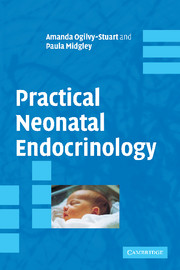Book contents
- Frontmatter
- Contents
- Acknowledgements
- Introduction
- 1 Hyperglycaemia
- 2 Hypoglycaemia
- 3 Management of hyperinsulinism
- 4 Hypoglycaemia in infant of a diabetic mother
- 5 Dysmorphic features
- 6 Micropenis
- 7 Hypopituitarism
- 8 Ambiguous genitalia (male): XY disorders of sex development
- 9 Cryptorchidism
- 10 Ambiguous genitalia (female): XX disorders of sex development
- 11 Pigmented scrotum
- 12 Adrenal failure
- 13 Collapse
- 14 Hypotension
- 15 Hyponatraemia
- 16 Hyperkalaemia
- 17 Hypernatraemia
- 18 Maternal steroid excess
- 19 Hypercalcaemia
- 20 Hypocalcaemia
- 21 Investigation and management of babies of mothers with thyroid disease
- 22 Maternal or familial thyroid disease
- 23 Goitre
- 24 Abnormal neonatal thyroid function tests
- 25 Hypothyroxinaemia in preterm infants
- Appendix 1 Calculation of glucose infusion rate
- Appendix 2 Dynamic tests
- Appendix 3 Normal ranges
- Appendix 4 Biochemistry samples
- Appendix 5 Formulary
- Index
3 - Management of hyperinsulinism
Published online by Cambridge University Press: 15 February 2010
- Frontmatter
- Contents
- Acknowledgements
- Introduction
- 1 Hyperglycaemia
- 2 Hypoglycaemia
- 3 Management of hyperinsulinism
- 4 Hypoglycaemia in infant of a diabetic mother
- 5 Dysmorphic features
- 6 Micropenis
- 7 Hypopituitarism
- 8 Ambiguous genitalia (male): XY disorders of sex development
- 9 Cryptorchidism
- 10 Ambiguous genitalia (female): XX disorders of sex development
- 11 Pigmented scrotum
- 12 Adrenal failure
- 13 Collapse
- 14 Hypotension
- 15 Hyponatraemia
- 16 Hyperkalaemia
- 17 Hypernatraemia
- 18 Maternal steroid excess
- 19 Hypercalcaemia
- 20 Hypocalcaemia
- 21 Investigation and management of babies of mothers with thyroid disease
- 22 Maternal or familial thyroid disease
- 23 Goitre
- 24 Abnormal neonatal thyroid function tests
- 25 Hypothyroxinaemia in preterm infants
- Appendix 1 Calculation of glucose infusion rate
- Appendix 2 Dynamic tests
- Appendix 3 Normal ranges
- Appendix 4 Biochemistry samples
- Appendix 5 Formulary
- Index
Summary
Clinical presentation
Incidental finding of hypoglycaemia on blood glucose testing.
Large birth weight.
Features of Beckwith–Weideman syndrome (large tongue, ear lobe creases, exomphalos, visceromegaly).
Small-for-gestational-age (SGA, due to dysregulation).
Rhesus disease (largely historical since the introduction of anti-D immunization and intrauterine transfusions; hyperinsulinism was presumed to be due to protein from the breakdown of red blood cells stimulating insulin release in utero).
Symptoms include:
Jitteriness and hypoglycaemic convulsions, but symptoms may be absent.
Investigations
For samples during hypoglycaemia:
See Chapter 2, Table of Samples to be taken during hypoglycaemia (p. 9, Table 2.1).
It is essential to include a sample for ammonia during hypoglycaemia on at least one occasion, to identify infants with activating glutamate dehydrogenase (GLUD1) mutations (see below).
Diagnosis
Diagnosis is based on the insulin level at the time of hypoglycaemia (when insulin production should be completely suppressed), and/or a glucose requirement ≥8 mg/kg/min. Ketone body and free fatty acid production should also be low, which may support the diagnosis, particularly in the situation where no insulin result is available.
Hyperinsulinism is the commonest pathological cause of neonatal hypoglycaemia and is usually transient (and less severe), but can be persistent (persistent hypoglycaemic hyperinsulinaemia of infancy (PHHI)) and more difficult to manage.
- Type
- Chapter
- Information
- Practical Neonatal Endocrinology , pp. 17 - 26Publisher: Cambridge University PressPrint publication year: 2006

